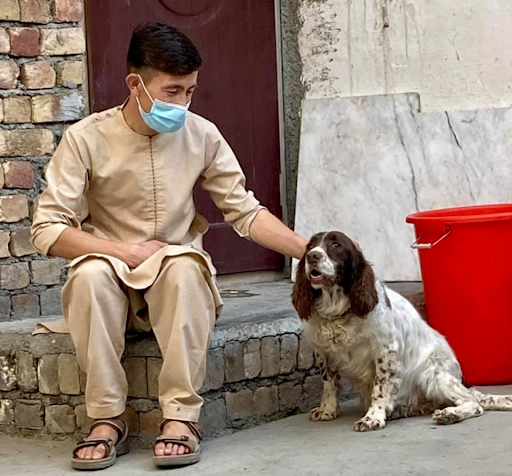Dogs, cats and other pets flee Afghanistan, CDC creates obstacle with temporary dog ban

Man petting a lost dog that the Kabul Small Animal Rescue took care of. Courtesy of Kabul Small Animal Rescue’s Facebook page.
As the Taliban takes a strong position in Afghanistan, people rush to the airport to seek refuge elsewhere. However, people are not the only ones rushing to the planes — cats, dogs and other pets are taking flights in hopes of a better future. The Center for Disease Control placed a temporary ban on July 14 preventing Afghan dogs from coming into the United States.
The CDC estimates that six percent of all dogs imported into the United States come from a country with a high risk of rabies, such as Afghanistan. According to the CDC, the United States has been free of canine rabies since 2007. This ban is an effort to protect other imported dogs coming from countries that provide more adequate vaccinations.
“Inadequately vaccinated dogs are not protected against rabies and are a public health threat,” the CDC says on its website. “Rabies is fatal in both humans and animals, and the importation of even one rabid dog could result in transmission to humans, pets and wildlife.”
For Charlotte Maxwell-Jones, the director and founder of Kabul Small Animal Rescue, this poses a big obstacle for bringing dogs into the states.
“Theoretically the CDC ban on dogs prevents us from moving dogs into the U.S., and much has been made of this, but it had nothing to do with why we couldn’t get the animals out of Kabul,” Maxwell-Jones told The DePaulia in an email.
Maxwell-Jones is trying to get an exception from the CDC for these dogs left in Afghanistan, but there is no guarantee. If an exception is not granted, the Kabul Small Animal Rescue plans to send dogs to Canada.
“Because the future of their lives and health is in peril here,” Maxwell-Jones wrote. “They will not survive or live decent lives.”
Regardless, getting as many animals to a new environment remains a top priority, despite these CDC regulations.
“[We’ve] evacuated 317 animals between Thanksgiving of 2020 and July 14 of 2021,” Maxwell-Jones wrote. “We hope to move another 250 or so when we do get a flight. As for other organizations, I believe Nowzad moved out just under 200 when they left, and at least a couple dozen in the year prior.”
The Kabul Small Animal Rescue has made a big impact on the animals of Kabul, but they still face ongoing financial hardship. Most funds go towards flights, while some expenses are allocated for medicine and staffing.
“We used to be mostly bankrolled by my day job as a research director at a think tank and supplemented by small grants here and there and personal donations,” Maxwell-Jones wrote. “Since this debacle started, we are funded by enormous personal donations, fundraisers run by SPCAI, War Paws, Animals Australia, Cuddly, Mutt Mutt Engine, Puppy Rescue Mission and others.”
Despite the ban, the United States has brought in a few dogs from Afghanistan. According to KARE11, the Home for Life animal sanctuary in Minneapolis took in seven dogs from Afghanistan, one of which is Bluebell — a stray dog involved in a car accident while still in Afghanistan. Bluebell broke a leg and eventually had to get it amputated due to an infection.
The Home for Life animal sanctuary plays a small role in supporting animals from such large-scale damage in collaboration with No Dog Left Behind, another dog rescue organization.”For somebody that is heartbroken about what’s going on over there and knowing how privileged we are here, knowing what’s going on there, is just eye-opening,” No Dog Left Behind’s Vetting Coordinator Chariss Nearmeyer told KARE11. “I wish we as a nation could talk about it more and pitch in more, and realize that there are people, dogs and cats and other animals that are still there with no voice.”












MELINDA NIX • Oct 6, 2021 at 11:00 am
The director of cdc wallensky is responsible for the deaths of dogs at kabul airport in Afghanistan; the 150 dogs were crated by ksar & brought to airport & had to wait 2 days ! although MS Jones received permission by congress to place the dogs in cargo in military plane to be airlifted to safety , the cdc director wallensky said ,”NO”..NOW THE DOGS ARE DEAD .THE DOGS’ CARCASSES HAVE BEEN FOUND AT OR NEAR AIRPORT !!! Since The cdc director wallensky , would not allow the dogs in crates to be boarded in unused cargo area ms Jones chose not to leave afghanistan & not leave dogs behind ; On the other hand, taliban would not allow Ms Charlotte mMaxwell Jones to return the dogs back to her rescue (ksar) ; When the Taliban finally gave Ms Jones permission to collect the dogs , (which included service dogs owned by contractors)the Dogs were all dead !! their carcasses were found at airport !! HOW HORRIFIC ! THE DIRECTOR OF CDC IS AN EVIL WOMAN WITH NO CONSCIENCE OR HEART ! I ONLY HAVE CONTEMT FOR WALLENSKY !!!
Diane Real • Oct 5, 2021 at 5:42 am
This country is filled with right wing hypocrites.
They care more about an unborn blastocyst human than they do the living, breathing.creatures God made with feelings and cognizant needs.
Screw the churches that waste time on running women’s lives instead of doing something wortwhile
for already born souls.
FYI ……God commanded mankind to take care of his creatures.
Olivia De La Paz • Oct 5, 2021 at 4:28 am
Still praying for Charlotte & ALL of her animals! I believe in miracles!!!
Paula Stahley • Oct 4, 2021 at 9:35 pm
Charlotte Maxwell Jones ran a series of fundraisers going back to before starting KSAR a couple of years ago. She was asking $3000 to get a cat ‘home’ when home was for Charlotte in Afghanistan. What did this mean? She also raised $3000 to send two cats to Chicago where the home in question was with her father. He appears to have quite a comfortable lifestyle but donors paid for the cats’ journey.
It has been well documented that Maxwell Jones was offered several routes out of Afghanistan with her animals but either refused or did not respond. Why was this? These did not involve transporting the animals to the US so the issue of the CDC was not an issue.
Since whatever happened at the Kabul airport during rhe evacuation of US military from Afghanistan at the end of August 2021, the image created has been carefully crafted to not give too much information but rather to post endless photos of cute animals with cute write ups on facebook. When any difficult questions arise, posts are made which are basically about Maxwell Jones herself, her feelings towards those questioning her and this is usually accompanied by a lot of swearing.
The sooner the truth comes out, the better. In the meantime watch those ongoing fundraisers.
Taylor Stephens • Oct 1, 2021 at 6:38 am
I feel horrible that Charlotte and all her animals have been left behind, just because of some CDC ban that was enacted in July. It’s not just dogs but she also has cats, sheep, and at least one bird. It makes me so sad and frustrated that they weren’t allowed to leave before the deadline and now they are in even more danger. I pray for ALL of them, tech and medical staff included, ALL animals in Charlotte’s care, and anyone involved in rescuing these poor innocent animals!
Susan Landry • Sep 28, 2021 at 12:15 am
Dogs lovepeople unconditionally they are loyal and they love better than humans. It’s so bad people don’t take good of dogs. They love better than people love. They are better caring suaan
JORGE A MAQUIN • Sep 22, 2021 at 5:42 pm
My little dog doesn’t have anything to do with this problem the CDC have with Inadequately vaccinated dogs We are visiting my 84 year old Mother in Guatemala City that was very sick we have to take my 3 years pet with us we left USA August 6 now we are not allow to bring Perlita our dog in to the USA because CDC release this new dog import permit we went for only two weeks to guatemala we already lost our trip last saturday because airline won’t accepted any pets without CDC dog import permit my wife went to the veterinary on July 26 to get a health certificate permit to take my pet perlita with us out of the USA they ask my wife where we were taking the pet she tell them that we plant to go to Guatemala for two weeks. This new disposition when on effect July 14 why they didn’t give us any advice no warnings information what so ever, same with the airline I call them the same day we flight and I ask for information and the representative from airline say there were no restrictions o